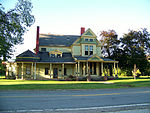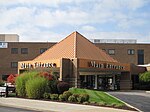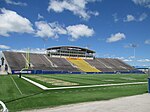Dix Stadium is a stadium in Kent, Ohio, United States. It is primarily used for American football, and is the home field of the Kent State Golden Flashes football team. In addition, since 2016 the stadium is also home to the Kent State women's soccer team and since 2019 to the women's lacrosse team. Previously, it was home to the Kent State field hockey team from 1997 to 2004 and served as a secondary home for the KSU men's soccer team in the 1970s. It opened on September 13, 1969 and was named in 1973 after Robert C. Dix, former publisher of the Record-Courier and a member of Kent State's Board of Trustees for more than three decades. It was built as an expansion and relocation of Memorial Stadium, with all of Memorial Stadium's main seating areas used at the current stadium in a new configuration. During soccer games, the playing surface is known as Zoeller Field.
Dix Stadium is located at the far eastern end of the KSU campus along Summit Street, just east of State Route 261 and is the center of an athletic complex, adjacent to the Kent State Field House, Murphy–Mellis Field, and Devine Diamond. The stadium hosts high school football games on a regular basis and served as the host of the 2001 NCAA Division I Field Hockey Championship, the 1998 and 2003 Mid-American Conference Field Hockey Tournaments, and the 2016 Mid-American Conference Women's Soccer Tournament.
The stadium consists of three separate grandstands on each side of the field except the south side, and has a seating capacity of 25,319. The west side grandstand, which includes the press box, is the largest section of seating, and the east side student seating is the smallest. On either side of the east grandstands are spaces for party tents, and the south end zone features the scoreboard and an open plaza. Although the first night game was held in 1990, permanent lights were not added until 1996. Artificial turf was installed in 1997 and replaced in 2005 with the latest version of FieldTurf. Prior to the 2002 season, the old east side stands, remnants of the Memorial Stadium, were demolished. The current east side bleachers were constructed after the 2002 season and were completed in time for the 2003 season opener. In early 2008, the south end zone bleachers, another remnant of the old stadium, were razed as part of a two-phase renovation of the facility. At its dedication, the stadium was listed as having a seating capacity of 30,520, reduced to 29,287 in 2003 after the east side seating was replaced.








